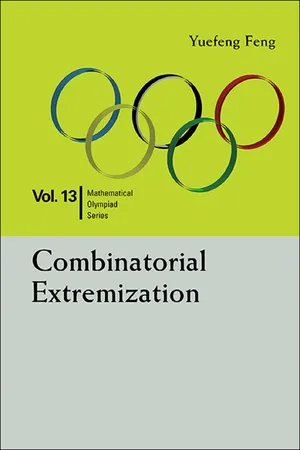
- 200 pages
- English
- ePUB (mobile friendly)
- Available on iOS & Android
Combinatorial Extremization
About This Book
In China, lots of excellent students who are good at maths takes an active part in various maths contests and the best six senior high school students will be selected to form the IMO National Team to compete in the International Mathematical Olympiad. In the past ten years China's IMO Team has achieved outstanding results — they have won the first place almost every year.
The author is one of the coaches of China's IMO National Team, whose students have won many gold medals many times in IMO.
This book is part of the Mathematical Olympiad Series which discusses several aspects related to maths contests, such as algebra, number theory, combinatorics, graph theory and geometry. The book elaborates on methods of discrete extremization, such as inequality control, repeated extremum, partial adjustment, exploiting symmetry, polishing transform, space estimates, etc.
Request Inspection Copy
In China, lots of excellent students who are good at maths takes an active part in various maths contests and the best six senior high school students will be selected to form the IMO National Team to compete in the International Mathematical Olympiad. In the past ten years China's IMO Team has achieved outstanding results — they have won the first place almost every year.
The author is one of the coaches of China's IMO National Team, whose students have won many gold medals many times in IMO.
This book is part of the Mathematical Olympiad Series which discusses several aspects related to maths contests, such as algebra, number theory, combinatorics, graph theory and geometry. The book elaborates on methods of discrete extremization, such as inequality control, repeated extremum, partial adjustment, exploiting symmetry, polishing transform, space estimates, etc.
Request Inspection Copy
Readership: Senior high school students engaged in math contests, math teachers, undergraduates of math major and math enthusiasts.
Key Features:
- China has performed outstandingly in IMO and the book gathers from the tutoring experience of many excellent teachers
- The author is one of the leading experts in aspects of maths contests in China as the coach of China's IMO National Team
- The Chinese version of the book has been very popular
Frequently asked questions
Information

Chapter 1Inequality Control




Table of contents
- Cover Page
- Title
- Copyright
- Contents
- Introduction
- Preface
- Chapter 1 Inequality Control
- Chapter 2 Repeated Extremum
- Chapter 3 Partial Adjustment
- Chapter 4 Exploiting Symmetry
- Chapter 5 Polishing Transform
- Chapter 6 Space Estimates
- Chapter 7 Block Estimates
- Chapter 8 Guesses and Contradiction
- Chapter 9 Global Estimates
- Chapter 10 Parameter Estimates
- Chapter 11 Counting in Two Ways
- Chapter 12 Shrinking the Encirclement
- Chapter 13 Considering Special Cases
- Solutions to Exercises